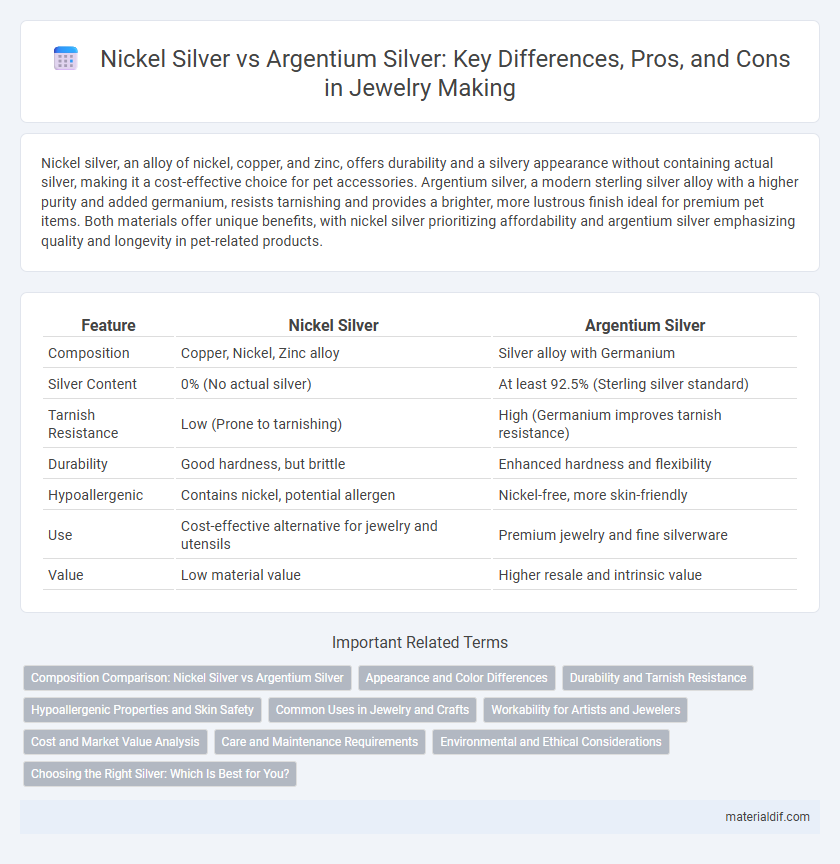Nickel silver, an alloy of nickel, copper, and zinc, offers durability and a silvery appearance without containing actual silver, making it a cost-effective choice for pet accessories. Argentium silver, a modern sterling silver alloy with a higher purity and added germanium, resists tarnishing and provides a brighter, more lustrous finish ideal for premium pet items. Both materials offer unique benefits, with nickel silver prioritizing affordability and argentium silver emphasizing quality and longevity in pet-related products.
Table of Comparison
| Feature | Nickel Silver | Argentium Silver |
|---|---|---|
| Composition | Copper, Nickel, Zinc alloy | Silver alloy with Germanium |
| Silver Content | 0% (No actual silver) | At least 92.5% (Sterling silver standard) |
| Tarnish Resistance | Low (Prone to tarnishing) | High (Germanium improves tarnish resistance) |
| Durability | Good hardness, but brittle | Enhanced hardness and flexibility |
| Hypoallergenic | Contains nickel, potential allergen | Nickel-free, more skin-friendly |
| Use | Cost-effective alternative for jewelry and utensils | Premium jewelry and fine silverware |
| Value | Low material value | Higher resale and intrinsic value |
Composition Comparison: Nickel Silver vs Argentium Silver
Nickel silver typically consists of about 60% copper, 20% nickel, and 20% zinc, offering a durable, corrosion-resistant alloy with a silver-like appearance but no actual silver content. Argentium silver is a modern sterling silver alloy containing 92.5% silver and a small percentage of germanium, which enhances tarnish resistance and increases strength compared to traditional sterling silver. The key compositional difference lies in nickel silver's lack of precious metal and Argentium silver's high silver content combined with germanium for improved performance.
Appearance and Color Differences
Nickel silver, also known as German silver, has a duller grayish appearance with a slight yellow tint due to its copper and nickel content, lacking the bright luster of true silver alloys. Argentium silver, a patented sterling silver alloy containing germanium, exhibits a brilliant white shine and enhanced tarnish resistance, maintaining its bright and reflective surface longer than traditional sterling silver. The color difference is notable: nickel silver's muted tones contrast sharply with Argentium silver's vivid, polished look favored in fine jewelry.
Durability and Tarnish Resistance
Nickel Silver, an alloy of copper, nickel, and zinc, is known for its high durability but lacks significant tarnish resistance, often requiring frequent polishing. Argentium Silver, a modern sterling silver alloy with added germanium, offers superior tarnish resistance while maintaining excellent durability. This makes Argentium Silver a preferred choice for jewelry and silverware that demands long-lasting shine and minimal maintenance.
Hypoallergenic Properties and Skin Safety
Nickel Silver contains nickel, which often triggers allergic reactions and skin irritation, making it less suitable for sensitive skin. Argentium Silver, an advanced sterling silver alloy, replaces nickel with germanium, significantly enhancing its hypoallergenic properties and reducing the risk of dermatitis. This makes Argentium Silver a safer and more skin-friendly option for individuals prone to metal allergies.
Common Uses in Jewelry and Crafts
Nickel silver, composed of copper, nickel, and zinc, is widely used in jewelry and crafts for its durability and affordability, often seen in costume jewelry, buttons, and ornamental pieces. Argentium silver, a modern sterling silver alloy with added germanium, is favored for its tarnish resistance and hypoallergenic properties, making it ideal for fine jewelry, heirloom items, and detailed silversmithing. Both materials offer distinct benefits, with nickel silver excelling in strength and cost-effectiveness, while Argentium silver provides superior luster and maintenance ease in crafted jewelry.
Workability for Artists and Jewelers
Nickel Silver offers high durability and affordability, making it easier for artists and jewelers to shape and work with heavy-duty pieces. Argentium Silver, known for its enhanced tarnish resistance and brighter appearance, provides superior malleability and soldering ease, ideal for intricate designs and fine detailing. Both materials offer distinct workability benefits, with Argentium favored for precision and Nickel Silver for robust, costume jewelry applications.
Cost and Market Value Analysis
Nickel silver is an affordable alloy composed mainly of copper, nickel, and zinc, offering durability but lacking the intrinsic value of precious metals. Argentium silver, a modern sterling silver alloy with added germanium, commands a higher market value due to its enhanced tarnish resistance and higher precious metal content. Cost analysis reveals nickel silver is significantly cheaper upfront, but Argentium silver holds greater long-term investment potential and resale value in the jewelry and silverware markets.
Care and Maintenance Requirements
Nickel silver requires regular polishing to prevent tarnish caused by copper content and is more prone to corrosion if exposed to moisture or chemicals. Argentium silver, a modern alloy containing germanium, offers superior tarnish resistance and requires less frequent cleaning, making it easier to maintain its shine over time. Both metals benefit from proper storage in anti-tarnish cloths and avoidance of harsh chemicals to preserve their appearance.
Environmental and Ethical Considerations
Nickel Silver, an alloy containing copper, nickel, and zinc, often raises environmental concerns due to nickel mining's significant ecological impact and potential for toxic waste. Argentium Silver, a modern sterling silver alloy with added germanium, offers improved durability and tarnish resistance, reducing the need for frequent polishing and chemical treatments, thereby minimizing environmental harm. Ethically, Argentium Silver production tends to follow stricter standards for sourcing metals, promoting more sustainable and responsible mining practices compared to conventional Nickel Silver manufacturing.
Choosing the Right Silver: Which Is Best for You?
Nickel silver, an alloy of copper, nickel, and zinc, offers excellent durability and a bright, silvery finish ideal for jewelry and decorative items that require strength and tarnish resistance. Argentium silver, a modern sterling silver variant with added germanium, provides superior tarnish resistance and hypoallergenic properties, making it a preferred choice for sensitive skin and fine jewelry pieces requiring long-lasting luster. Choosing between nickel silver and Argentium silver depends on priorities like avoiding tarnish and allergies with Argentium or requiring the robust strength and affordability of nickel silver.
Nickel Silver vs Argentium Silver Infographic

 materialdif.com
materialdif.com